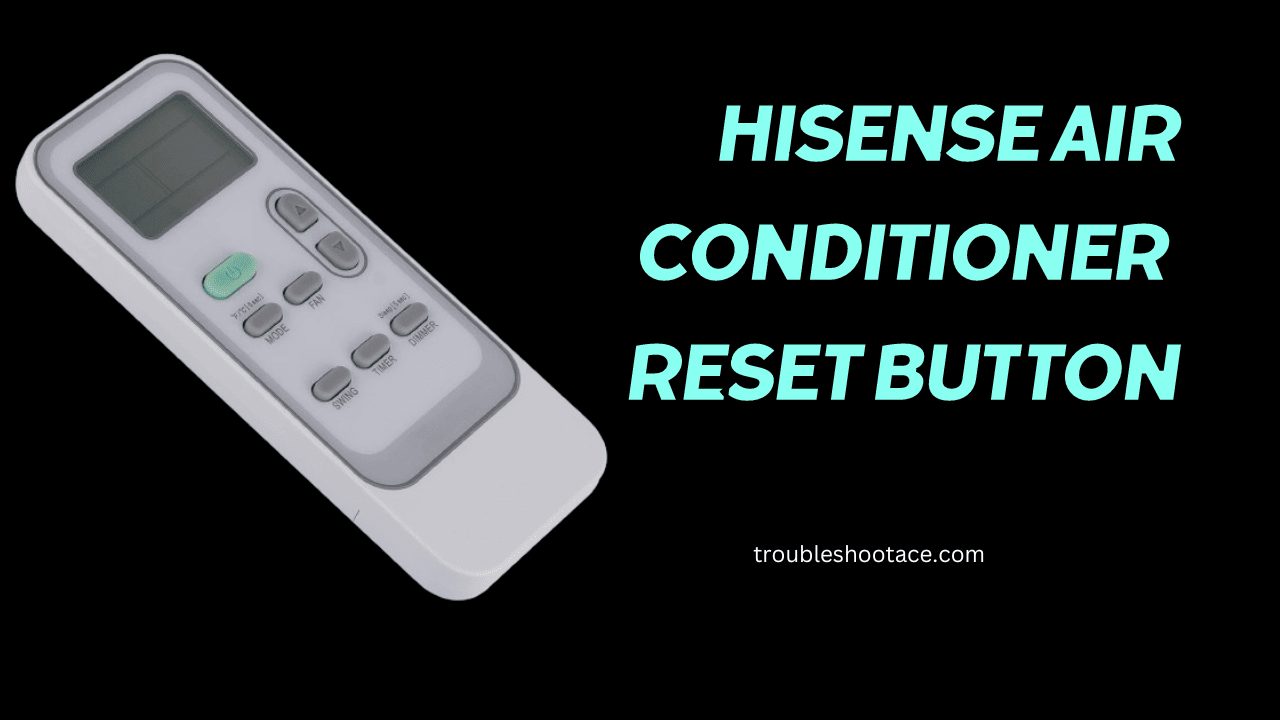Introducing our ultimate guide to resetting your Hisense air conditioner. When your AC unit is causing you problems, finding and pressing the reset button of the Hisense air conditioner is a fantastic skill.

This post will give you a step-by-step guide as well as use very simple language for resetting your air conditioner easily. The aim is that after reading this post, you should be able to solve the most common problems with your Hisense air conditioner without stress and also make sure it works in the best way possible.
Understanding the Importance of the Reset Button
The reset button on your Hisense air conditioner is an important part of the troubleshooting process for different issues that may come up on your AC unit. It is an essential tool used in solving problems and bringing back effective working conditions.
Efficient AC Troubleshooting
If your air conditioner has some problems like not cooling properly, behaving erratically, or not responding, a simple solution could be pressing the reset button. This will reset everything to where it should be and fix all the common problems that can affect any device.
Most times, this will save you time from having to call in professionals because most problems can be resolved by merely pressing a single button.
Common Issues that Can be Fixed
The reset button is designed to address typical problems with air conditioners, such as freezing, loud noises, and unresponsiveness. These issues often stem from power surges, temporary glitches, or conflicting settings.
Using the reset button, you can troubleshoot these problems effectively and return your AC unit to its normal operation. This is a handy feature that offers quick fixes for comfort- or convenience-threatening situations.
Also Read: Portable Air Conditioner Blows Cold Then Warm
Enhancing the Lifespan of Your AC Unit
Regularly pressing the reset button when servicing your Hisense air conditioner can help it last longer. By dealing with matters as soon as they come up. you prevent more harm and make sure the appliance works optimally.
Continual maintenance and problem-solving also cut the chances of major breakdowns, sparing you from expensive repairs or having to buy a new AC unit prematurely. The reset button is useful here because it helps in identifying and dealing with problems before they get worse.
Empowering AC Owners
Recognizing how vital the reset button is will make AC owners more competent in handling their cooling systems. This approach offers an easy solution to several frequently occurring issues.
As a result, it diminishes the necessity for professional assistance and enhances your ability to deal with breakdowns independently. Understanding the purpose of a reset button and how it can benefit you will help you take care of your Hisense air conditioner more effectively.
Thus, you will maximize its efficiency so that it can provide uninterrupted comfort throughout the day at home or work.
Locating and Using the Hisense Air Conditioner Reset Button
If your Hisense air conditioner is giving you trouble, you can use the reset button to help get it working again. Here, you can learn how to find and use the reset button on your AC unit with step-by-step instructions.
Step 1: Locate the Reset Button
The first thing you should do is put the reset button on your Hisense air conditioning system. It is usually found on or near the control panel, but this may differ by model. Make sure to look carefully for this button.
Step 2: Preparation Before Pressing the Reset Button
Before pressing reset on your Hisense unit, make sure that it is turned off at all times. This will help in safeguarding the appliance as well as averting any possible electric faults while performing a reset.
Step 3: Press the Reset Button
Turning off your air conditioner first, grab a pointed device like a pin, and press & hold the reset button using it. Continuously keep holding it down for about 5-10 seconds then release. By doing this, you allow the appliance to reset itself and get rid of any transient faults that could be causing malfunctions.
Step 4: Power On Your Air Conditioner
After you’ve let go of the reset button, it’s time to turn on your Hisense air conditioner. You can do this by using either the power button found on the control panel or with the remote control. You’ll need to wait a little while for it to start up again and resume normal functions.
Remember: the reset button is there as a last resort. If you haven’t already, make sure that you’ve checked other possibilities like checking if the power supply is okay.Making sure the filter is clean; adjusting thermostat settings, etc.
In case this doesn’t help, please refer to the user manual. Get in touch with the customer support team at Hisense for further assistance.
Benefits of Using the Reset Button |
Common Issues Resolved |
| Quick and easy troubleshooting | Inconsistent cooling/heating |
| Restores factory defaults | Frozen evaporator coils |
| Resets error codes | Unresponsive controls |
| Strange noises or vibrations | |
| Intermittent operation |
Conclusion
Knowing how to find and use the reset button on your Hisense air conditioner is important. This will help you when you have problems and need to fix them. You’ll be able to fix any common issues that might come up with your Hisense unit by following these steps for resetting it.
Many different things could be wrong, such as the thermostat not working properly, cooling too slowly, or odd noises the AC unit makes. However, often all it takes is pressing this button to get everything back to normal again. So don’t forget about doing so if something goes awry.
If you can’t locate the reset button on the control panel of your Hisense air conditioner. Check the user manual that came with the product or visit their website for specific instructions related to your model. While most models have theirs situated here on the board there may be some variation. Most of these steps outlined in our guide entitled THE AC RESET will help out during regular maintenance checks to Identify what might

